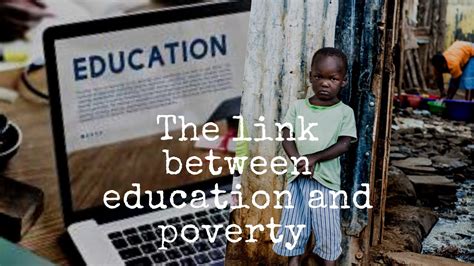

Education VS Poverty: The Powerhouse Duo for a Better 2025
Poverty has long been a global concern, affecting millions worldwide. But amidst the challenges, there emerges a beacon of hope: education. Unarguably, education is the most potent weapon in the fight against poverty, empowering individuals and communities to break free from its shackles.

The Vicious Cycle of Poverty
Poverty is a complex issue with multiple contributing factors. However, one of its most insidious aspects is the intergenerational cycle. Children born into poverty often face significant barriers to education and opportunity, perpetuating the cycle.
- According to the World Bank, an estimated 43% of children living in extreme poverty in 2018 did not complete primary school.
- Children in disadvantaged communities often lack access to quality education, adequate nutrition, and healthcare.
- Poverty can lead to stress and instability, which can impact children’s mental health and academic performance.
Education: The Catalyst for Change
Education holds the key to breaking the vicious cycle of poverty. It provides individuals with the skills, knowledge, and critical thinking abilities necessary to navigate the complex world of work and life.
- A study by UNESCO found that people with at least a secondary education earn, on average, 50% more than those with no education.
- Education empowers people to make informed decisions about their health, finances, and social well-being.
- It promotes social mobility, allowing individuals to move beyond their socioeconomic circumstances and achieve their full potential.
Strategies for Harnessing Education’s Power
To effectively harness the power of education in the fight against poverty, several strategies can be employed:
- Expanding Access to Quality Education: Ensure all children have access to affordable, quality education, regardless of their background.
- Investing in Early Childhood Education: Provide early childhood education to children from disadvantaged backgrounds, giving them a strong foundation for future learning.
- Vocational Training and Skill Development: Offer vocational training and skill development programs to youth and adults, enabling them to acquire marketable skills and increase their employability.
- Addressing Barriers to Education: Identify and address barriers to education, such as gender inequality, lack of transportation, or cultural factors.
The Role of Governments, NGOs, and Communities
Education VS Poverty is a battle that requires the collective efforts of governments, NGOs, and communities alike.
- Governments: Governments have a crucial role in providing adequate funding, resources, and policies for education.
- NGOs: NGOs can supplement government efforts by providing educational programs, training, and support services to marginalized communities.
- Communities: Communities can create a supportive environment for education by promoting literacy, encouraging school attendance, and providing access to resources.
Tips and Tricks for Effective Education Initiatives
- Personalize Learning: Tailor educational programs to meet the individual needs of students, ensuring accessibility and effectiveness.
- Engage Families and Communities: Involve parents and communities in the education process, fostering support and collaboration.
- Embrace Technology: Integrate technology into education to enhance access, flexibility, and learning experiences.
- Monitor and Evaluate Outcomes: Regularly track and evaluate the progress of education initiatives to identify areas for improvement and ensure accountability.
Conclusion
Education is the ultimate weapon in the fight against poverty, empowering individuals and communities to break the cycle of disadvantage. By investing in education, we invest in a future where all people have the opportunity to reach their full potential, regardless of their socioeconomic circumstances. Let us harness the power of education to create a more equitable and prosperous world for all by 2025.
Table 1: Global Education Statistics
| Indicator | Value |
|---|---|
| Number of children out of school (primary level) | 57 million |
| Percentage of young adults (aged 15-24) with no education | 12% |
| Number of teachers needed to achieve universal primary education | 26 million |
Table 2: Benefits of Education for Individuals
| Benefit | Impact |
|---|---|
| Increased earning potential | Higher income levels |
| Improved health outcomes | Better nutrition, reduced disease |
| Social mobility | Enhanced opportunities for career and life advancement |
| Critical thinking skills | Problem-solving abilities, decision-making |
| Confidence and self-esteem | Increased self-awareness, empowerment |
Table 3: Strategies for Expanding Access to Education
| Strategy | Impact |
|---|---|
| Conditional cash transfers | Encourage school attendance and retention |
| School feeding programs | Improve nutrition and reduce absenteeism |
| Transportation subsidies | Address transportation barriers to education |
| Flexible education options | Cater to the needs of working learners and adults |
| Community-based learning centers | Provide access to education in underserved areas |
Table 4: Role of Stakeholders in Education VS Poverty
| Stakeholder | Role |
|---|---|
| Governments | Provide funding, policies, and resources |
| NGOs | Supplement government efforts, provide targeted support |
| Communities | Create a supportive environment, encourage school attendance |
| Teachers | Provide quality instruction, engage students |
| Parents | Support children’s learning, advocate for education |










